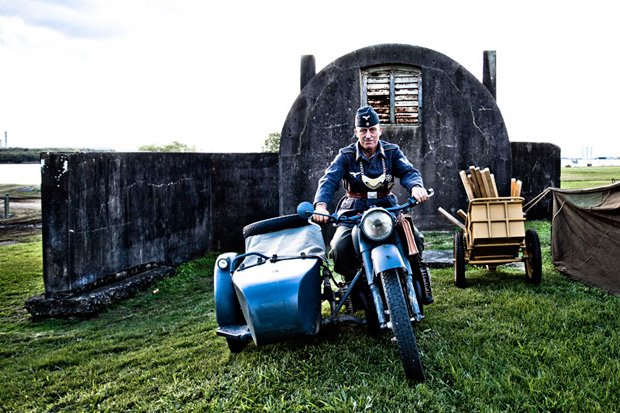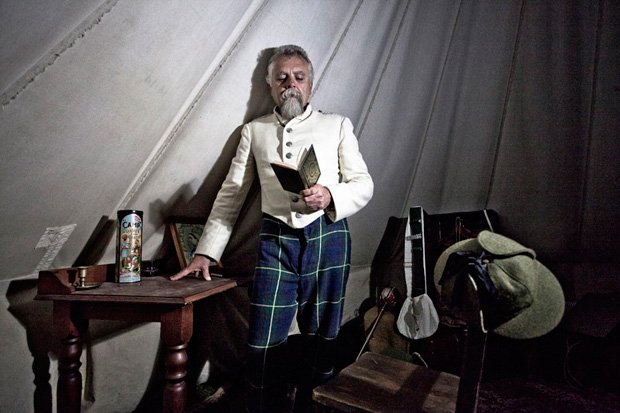Gallery: Reliving the Medieval period

“I’ve had my head split open a few times,” says Liam Reilly. He performs Medieval re-enactment with living-history group Knights of the Empire Germanica and explains that it can be a dangerous hobby. “We don’t just use swords, it’s also hammers, axes, spears and daggers, and we do a bit of unarmed combat as well,” he says. The group trains weekly and Liam says they try to make their combat as safe and historically accurate as possible.

With his replica BMW R71 motorcycle and sidecar, Matthew van Wyk performs a Second World War re-enactment at Fort Lytton. He is a member of Army Group South, an Australia-wide, living-history organisation, the members of which re-enact a number of different periods of twentieth-century military history.

Men wearing plumed Napoleonic hats gather near the main arena at the History Alive festival to watch a medieval tournament take place. A melting-pot of human history, the festival includes 37 re-enactment groups who come together to recreate more than 2000 years of world history.

‘Sir’ Garreth Johnston and his wife ‘Dame’ Gynette Johnston have been performing historical re-enactment for 17 years. While it’s the combat and weaponry that attracts Garreth, Gynette enjoys researching medieval costumes and recipes. “Usually we do a feast at these events and I do the cooking for the group,” she says. All of the food is prepared as it would have been during the thirteenth and fourteenth centuries.

Costumes are an important part of historical re-enactment. Many of the costumes worn at a festival are hand-made and extensive research goes into making sure everything – from the clothes re-enactors wear to the stoves they use to cook their meals, the armour and weapons they carry, and the tents and beds they sleep in – is as historically accurate as possible.

This German Panzer tank was just one of the military vehicles that featured at the 2012 History Alive festival. Among others were a replica 1940s motorcycle and sidecar, and an authentic 1937 Plymouth.

If it wasn’t for the oil refinery steaming away in the background, it might seem as though Peter (Pops) Alexander was standing in a scene from the nineteenth century. A member of the American Civil War Roundtable of Queensland re-enactment group, he recreates Australia’s Colonial history.

Clad in chainmail and heavy armour, and carrying steel swords, axes and shields, members of medieval re-enactment groups the ‘Knights Order of Lion Rampant’, ‘Knights of the Empire Germanica’ and the ‘Citadel Medieval Society’ battle against each other in a fourteenth-century tournament.

“We try to bring as little non-period stuff along as possible,” says Louise Howard as she prepares to spend the night in a nineteenth-century camp at Fort Lytton. Dressed in a corset and hand-made silk dress, she depicts a woman from Victorian-era Queensland. “This event isn’t about people dressing in period costume during the day and then camping in modern tents on blow-up mattresses at night, it’s about having an immersive experience.”

Historian Brian Rough has been involved in military re-enactment for nearly 30 years. Camped in a canvas bell tent and dressed in the uniform worn by the Queensland Scottish Volunteer Corps during the late-nineteenth century, he tries to bring Fort Lytton’s local military history to life during the History Alive festival.

Dressed in replica First World War uniforms, young Aiden Barton-Barnes (at left) and Travis York explore the History Alive festival. They are part of a military re-enactment group that depicts the 9th Australian Infantry Battalion, a local battalion that was based in Brisbane’s Moreton Bay Area.

A row of spectators, including Shelby Russon, watches a fourteenth-century tournament unfold at History Alive. Shelby has been a member of medieval re-enactment group the Knights Order of Lion Rampant for five months, and History Alive is the first festival she has taken part in. “It’s really thrilling to watch the tournament,” she says. “It’s like watching an action sports event.”

Inside the Knights of the Empire Germanica tent, Liam Harvey Ford gets dressed as a knight for battle with the help of his squire, Aaron Jensen. The fighting is based on theatre fencing and Liam says a lot of study and research goes into making it as historically accurate as possible. The techniques he uses are adapted from those described in manuscripts that date from the twelfth to the sixteenth centuries.

“My armour weighs about 40kg,” says Peter Molen, who has been performing medieval re-enactment for about two years. It takes him more than an hour to get into his combat costume, which includes hand-sewn underclothes, a chainmail suit, a leather harness, split steel armour, a steel helmet and steel sword.

Members of Brisbane-based living-history group Knights of the Empire Germanica prepare for a medieval tournament at the 2012 History Alive festival. The group, which includes Aaron Jensen (at left), Mark Ford (at centre) and Rachal Jansen (at right), meets each Sunday to workshop combat techniques, piece together their armoury and hand-sew their costumes. “A lot of work goes on behind the scenes to make all of this happen,” says Rachal.

For the past three years, Rachal Jansen has represented living-history group Knights of the Empire Germanica at History Alive. Each re-enactment group at the festival tries to create an immersive historical experience by wearing period dress, sleeping in period tents and eating meals that would have been prepared during their particular historic period.

At Fort Lytton, a cluster of canvas A-frame and bell tents replicate those used by the Queensland Scottish Volunteer Corps in the late 1880s. The camp includes a working field kitchen complete with an authentic Soyer stove, in which a topside roast boils to feed a group of historical re-enactors at the 2012 History Alive festival.

Home Topics History & Culture Gallery: Reliving the Medieval period


